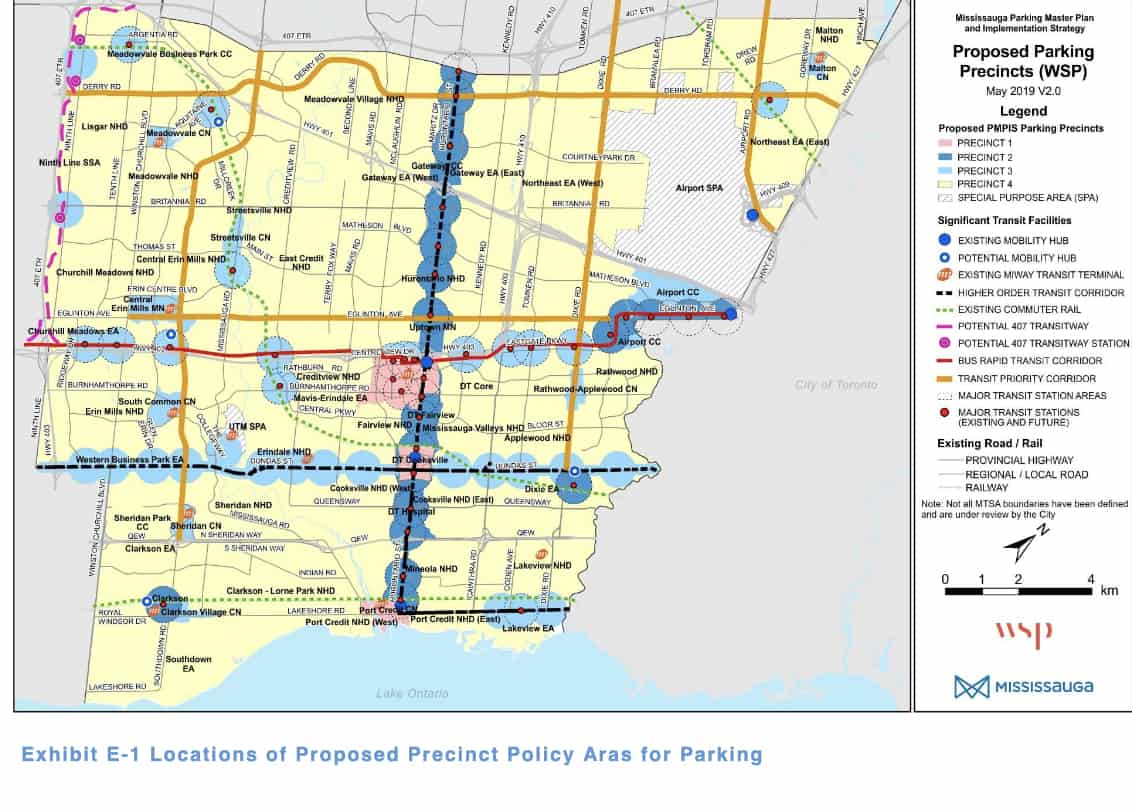Big Changes Proposed for Parking in Mississauga
Published May 14, 2019 at 8:04 pm

When people travel to dense urban cities, they typically expect to pay for parking–whether that be on the street or in a municipal lot.
In Mississauga, residents have typically enjoyed unfettered access to sprawling lots that are generally free to use. In most parts of the city–save for parts of Streetsville and Port Credit–street parking remains free.
But in a city that’s growing and rapidly urbanizing (46 new condo tours have been proposed for City Centre alone over the next 10 years), it’s becoming more critical for the city to manage parking policies and decide how to tackle street and lot parking going forward.
For that reason, the City of Mississauga’s proposed Parking Master Plan, “Parking Matters” has been published for public comment.
The master plan details how community parking will evolve as the city continues to grow and transform. The city says the plan reflects the input received during public and stakeholder consultations that were conducted over the past two years.
“The Parking Master Plan and Implementation Strategy looks at all aspects of parking in Mississauga,” said Andy Harvey, director, Traffic Management and Municipal Parking.
“Parking policy, planning, funding and emerging technologies were studied to develop an approach to parking that is made for Mississauga. The Parking Master Plan will help improve efficiency, manage parking in the future and better align public and private parking with transportation and economic development goals across the city.”
The master plan provides short, and long-term recommendations focused on 10 themes. These include municipal parking provisions and management, funding and finance, safety and accessibility and technology and innovation.
The plan points out that tackling parking challenge is crucial, as 15 per cent of total land use is estimated to be dedicated to off-street parking facilities and access driveways.
It also points out that, as of now, Mississauga is a city where the car is still king. In 2011, approximately 85 per cent of trips into, out of or around Mississauga were taken in a vehicle. As of 2016, households in Mississauga owned an average of 1.6 cars per household. The number of cars per household varies significantly from neighbourhood to neighbourhood with some having less than one car per household and others having more than three.
“As Mississauga is mostly “built out,” city builders need to look for innovative ways to use land more effectively to get the most out of each property and new development site and maintain affordability,” the plan reads.
“It is important for the city to look at how existing resources dedicated to parking and transportation can be used more efficiently and effectively. Parking policy can no longer be a one-size fits all approach.”
The plan suggests that continually providing free parking to residents and visitors could become something of a hardship, adding that the cost of providing complimentary parking needs to be “recognized and reconsidered.”
The document says that parking lots and spaces influence city building, transportation choices and economic development.
“The city should strive to ensure a balance between parking provision and management to maximize support for Mississauga as a multi-modal city. Finally, the city should strive to ensure a fair distribution of parking costs,” the plan reads.
The plan suggests the city base its parking policies on the needs of separate precincts, with four parking precinct areas recommended for Mississauga.
 Precinct one will have the lowest parking requirements, the highest level of parking management strategies, and consideration of parking maximums for most land uses. Precinct four will boast appropriate minimum parking requirements that will be among the highest in the city.
Precinct one will have the lowest parking requirements, the highest level of parking management strategies, and consideration of parking maximums for most land uses. Precinct four will boast appropriate minimum parking requirements that will be among the highest in the city.
With the city aiming to make public transportation more user-friendly and ubiquitous–especially with the Hurontario LRT slated for completion within the next four years–it’s hoping to reduce the need for excessive public parking throughout parts of the city. The plan also notes that the rise of ridesharing companies such as Uber and Lyft might lessen the need for parking.
“To realize the city’s strategic goal of a transit-oriented city, the city’s existing minimum parking requirements should be reduced and replaced with a policy designed to manage parking demand more deliberately,” the plan reads.
The plan says the city should consider establishing maximum parking requirements in all precincts as part of a future, detailed zoning bylaw review.
Developers asking for more parking will have their request evaluated on a case-by-case basis.
As far as street parking goes, residents are welcome to request some changes. As of now, drivers can park on city roads for up to five hours (unless signage indicates otherwise). On-street parking is prohibited between 2:00 am, and 6:00 am. On statutory holidays, parking is permitted between 8:00 am and midnight without time restriction.
The policies surrounding parking on statutory holidays aren’t expected to change.
However, residents can request that the city evaluate its current on-street parking rules.
The plan says residents can request changes to parking restrictions through a petition program. The program requires a petition showing support from at least 66 per cent of affected homeowners, a technical review by the city, and approval by the ward councillor.
The plan says typical requests are to extend the five-hour parking limit, to allow lower driveway boulevard parking (which is allowed in some areas as long as the sidewalk is not obstructed), and to reduce local parking prohibitions.
As far as permits go, there are currently five types of on-street parking permits offered by the city, including residential short-term temporary, residential long-term, commercial blanket, residential blanket, and carshare permits.
The plan recommends that the city develop a digital on-street parking permit program for processing, operating and enforcing the program.
The plan also recommends that the city implement an on-street overnight parking program in residential areas to work in alignment with the review of the zoning bylaw requirements and the potential reductions in certain precincts (for example, parking requirements for basement apartments could be waived in areas within the overnight permit parking program, or where boulevard parking is feasible).
So, will the city introduce more paid parking going forward?
The says it will continue to monitor on-street parking occupancy in precincts one, two and three (specifically Port Credit, the Downtown, Streetsville, Clarkson, and Cooksville).
The plan says that to improve the management of parking demand and to encourage turnover in areas that charge for parking, the city should increase parking fees when parking occupancy exceeds 85 per cent during peak hours in these areas.
As for new paid parking spots, those are a possibility. The plan says that to improve the management of parking demand and to encourage turnover in areas that do not charge for parking, the city should consider introducing parking fees when parking occupancy exceeds 50 per cent during peak hours.
The plan also says that existing parking fees should increase over time to keep pace with inflation.
GO Transit users should also note that the plan calls for the city to work with Metrolinx to develop a strategy to reduce all-day free parking at GO Transit rail and bus stations.
In good news for residents and visitors looking for overnight parking in municipal lots, the plan says the city should review the feasibility of removing overnight parking prohibitions at all its off-street parking facilities.
The plan also says the city should consider opportunities to partner with the private sector where appropriate and beneficial for providing parking or developing shared parking arrangements.
The plan says the city should also look into parking lot safety, as residents often report slipping and falling in lots. The plan also notes that some residents feel unsafe in underground lots and parking garages, as they’re not visible to the public when walking through the structures.
As far as ease of parking goes, the plan recommends the city invest in technology to make paying for parking more manageable. The plan says the city should consider upgrading its pay and display machines and enforcement technology to a PBLP (pay by licence plate) system.
All input received by May 31 will be considered.
The master plan will go to General Committee for approval on June 12.
To learn more about the plan, click here.
insauga's Editorial Standards and Policies advertising





